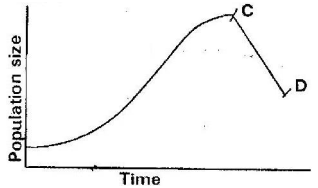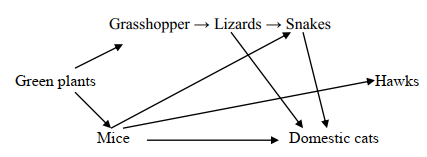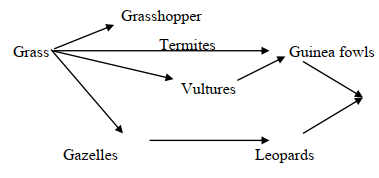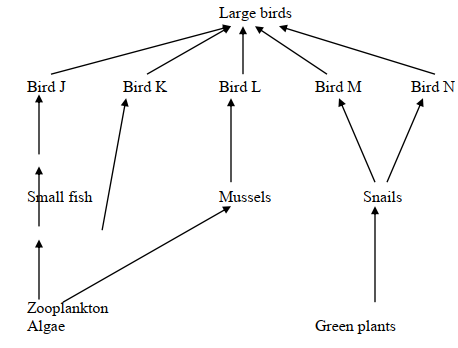Questions
- State how excessive use of pesticides may affect soil fertility
- The graph below represents a population growth of a certain herbivore in a grassland ecosystem over a period of time.
Suggest three factors that could have caused the population change between C and D (3 marks) - A biologist carried out a study to investigate the growth of a certain species of herbivorous bony fish and the factors influencing plant and animal life in four lakes A, B, C and D. The lakes were located in the same geographical area.
Two of the lakes A and B were found to contain hard water due to presence of high content of calcium slats. The mean body length of 2 year old fish, amount of plant life and invertebrates biomass in each lake were determines. The data was as shown in
Lakes Mean body length (cm) Type of water Amount of plant life Inveertebrate biomass (g/cm3) Insects Snails Crabs Worms A
B
C
D31.2
28.6
18.4
16.3Hard
Hard
Soft
Soft1050
950
1.2
0.511
72
97
99300
100
0 010
9
2
1180
90
20
10- Describe the procedure that may have been used to determine the mean body length of the fish ( 6 marks)
- What are the likely reasons for the difference in the mean body length of the fish living in lakes A and D? ( 4 marks)
- Suggest one reason for the absence of snails in lakes C and D? (1 mark)
- Name any six abiotic (physical) factors that are likely to influence the plant and animal life in lake A. ( 3 marks)
- Explain how each of the factors named in (i) may influence the plant and animals life in Lake A. ( 6 marks)
- During an ecological study of a lake a group of students recorded the following observations.
(i) Planktonic crustaceans feed on planktonic algae
(ii) Small fish feed on planktonic crustaceans worms and insect larvae
(iii) Worms feed on insect larvae
(iv) Bird species feeds on small fish planktonic crustaceans and worms
(v) Insect larvae feed on small fish- From this record of observations construct a feed web (5 marks)
- From the food web you have constructed in (a) above isolate and write down a food chain that ends with
- Bird species as a secondary consumer (1 mark)
- Large fish as tertiary consumer (1 mark)
- The biomass of the producers in the lake was found to be greater than that of primary consumers. Give an explanation for this observation? (1 mark)
- Using either the observations recorded by the students or the food web you have constructed name (1 mark)
- Two organisms that compete for food in the lake. (2 marks)
- The source of food the organisms in d (i) above compete for (1 mark)
- State three ways by which many may interfere with this lake ecosystem ( 3 marks)
- Explain how each of the ways you have states may affect life in the lake? ( 6 marks)
- In an investigation, a student collected two plants A and B. Plant A had hairy leaves and epidermis. Leaves of plant B
- Plant A ( 1 mark)
- Plant B ( 1 mark)
- An investigation was carried out between 1964 and 1973 to study the changes of fish population in a certain small lake. Four species of fish A, B, C and D were found to live in this lake. In 1965 a factory was built near the lake and was found to discharge hot water into the lake raising the average temperature from 250C to 300C. In 1967 sewage and industrial waste from a nearby town was diverted into the lake was stopped. The fish population during the period of investigation is shown in the table below.
Fish species Fish population during the period 1964 1966 1969 1970 1971 1972 1973 A
B
C
D6102
208
36
4521223
30
100
27226
11
0
23106
22
0
27660
63
0
794071
311
0
4007512
405
0
617-
- In which year were the fish populations lowest?
- State the factors that might have caused the lowest fish populations during the year you have stated in (a) (i) above ( 3 marks)
- Explain how each factor you have stated in (a) (ii) above could have brought about the changes in fish populations (11 marks)
- What is the difference in the rate of population recovery of species A and D? (1 mark)
- Suggest two biological factors that could have led to this difference (2 marks)
- State a method that might have been used to estimate the fish population in the lake ( 1 mark)
- State one disadvantage of the method you have stated in (c) (i) above (1 mark)
-
- Industrial wastes may contain metallic pollutants. State how such pollutants may indirectly reach and accumulate in the human body if the wastes were dumped into rivers.
- State three measures that can betaken to control infection of man by protozoan parasites ( 3 marks)
- The chart below shows a feeding relationship in a certain ecosystem
- Construct two food chains ending with a tertiary consumer in each case (2 marks)
- Which organisms has the largest variety of predators in the food web? (1 mark)
- Name secondary consumers in the food web ( 2 marks)
- Suggest three ways in which the ecosystem would be affected if there was prolonged drought ( 3 marks)
- To estimate the population size of crabs in a certain lagoon, traps were laid at random. 400 crabs were caught, marked and released back into the lagoon. Four days later, traps were laid again and 374 crabs were caught. Out of the 374 crabs, 80 were found to have been marked.
- Calculate the population size of the crabs in the lagoon using the formula below
N = n x M
M
Where
N= Total population of crabs in the lagoon
n= Total number of crabs in the second catch
M= Number marked crabs during the first catch
M= Number of marked crabs in the second catch. ( 2 marks) - State two assumptions that were made during the investigation ( 2 marks)
- What is the name given to this method of estimating the population size? (1 mark)
- Calculate the population size of the crabs in the lagoon using the formula below
- The figure below represents a feeding relationship in an ecosystem
- Write down the food chains in which the guinea fowls are secondary consumers (1 mark)
- What would be the short term effects on the eco- system of lions invaded the area? ( 3 marks)
- Name the organisms through which energy from the sun enters the food web. (1 mark)
- The diagram below represents a simplified nitrogen cycle
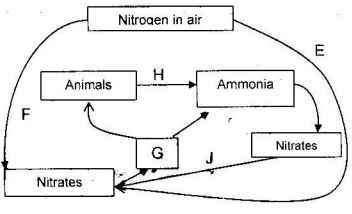
- Name the organisms that causes processes E and J ( 2 marks)
- Name the processes represented by F and H (2 marks)
- Name the group of organisms represented by c (i)
- Distinguish between a community and a population (2 marks)
- Describe how a population of grasshopper in a given area can be estimated (5 marks)
- Explain how the various activities of man have caused pollution of air ( 20 marks)
- Explain how birds of prey are adapted to obtaining their food ( 2 marks)
- Name the crop infested by phytophthora infestants and the disease it causes
Crop -
Disease - - State four control measures against the diseases ( 4 marks)
- Name the crop infested by phytophthora infestants and the disease it causes
- Explain why the carrying capacity for wild animals is higher than for cattle in a given piece of land ( 2 marks)
- What is meant by
- Autecology ( 1 mark)
- Synecology ( 1 mark)
- The number and distribution of stomata on three different leaves are shown in the table below
Leaf Number of stomata Upper epidermis Lower epidermis A
B
C300
150
020
200
13
Suggest the possible habitat of the plants from which the leaves were obtained. (3 marks)
Leaf Habitat
A ____________________
B ____________________
C ____________________ - State the modification found in the stomata of leaf C
- What is meant by
- Name the organism that causes amoebic dysentery.
- After an ecological study of feeding relationships students constructed the food web below
- Name the process through which energy from the sun is incorporated into the food web ( 1 mark)
- State the mode of feeding of the birds in the food web (1 mark)
- Name two ecosystem in which the organisms in the food web live( 2 marks)
- From the information in the food web construct a food chain with the large bird as a quarter – nary consumer ( 1 mark)
- What would happen to the organisms in the food web if bird N migrated?
- Not all energy from one trophic level is available to the next level. Explain (3 marks)
- Two organisms, which display a role in the ecosystems, are not included in the food web. Name them. ( 1 mark)
- State the role played by the organisms named g (i) above. (1 mark)
- State three human activities that would affect the ecosystems ( 3 marks)
- How would the activities stated in h (i) above affect the ecosystems? (3 marks)
- How is aerenchyma tissue adapted to its functions? ( 2 marks)
- Explain how abiotic factors affect plants ( 20 marks)
- What is the importance of the following in an ecosystem? ( 3 marks)
- Decomposers
- Predation
- Chart below represents a simplified nitrogen cycle
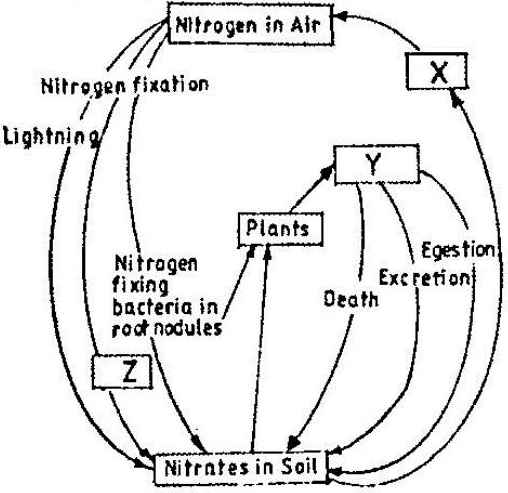
What is represented by X, Y and Z? ( 3 marks) - Distinguish between pyramid of numbers and pyramid of Biomass (2 marks)
- Give three reasons for loss of energy from one trophic level to another in a food chain. ( 3 marks)
- Describe how the belt transect can be used in estimating the population of a shrub in a grassland ( 2 marks)
- Distinguish between population and community ( 2 marks)
- Name a method that could be used to estimate the population size of the following organisms
- Fish in a pond ( 1 mark)
- Black jack in a garden ( 1 mark)
- State two ways in which schistosoma species is adapted to parasitic mode of life
- Describe causes and methods of controlling water pollution ( 20 marks)
- What is biological control of population growth? ( 2 marks)
- Describe one example where biological control has been used successfully (2 marks)
- Explain why the number of predators in nay ecosystem is less than the number of their prey ( 1 mark)
- Suggest reasons to account for the following observations.
- Antelopes are more commonly found in open grassland while giraffe while giraffes are commonly found in wooded areas. ( 2 marks)
- In the savannah there is a wider variety of herbivores in wooded areas than in open grassland ( 1 mark)
- Removal of predators for an herbivore may in the long run lead to a decrease in its population
- Explain why primary productivity decreases with depth in aquatic environments. (2 marks)
- The following is a simplified drawing of nitrogen cycle.

- Identify the compound named A ( 1 mark)
- Name the processes
X _________________
Y _________________
Z _________________ - In what form is nitrogen found in plants and animals?
- An investigation was carried out to study the type of food eaten by birds found in forest and savannah in a certain area. The table below compares the feeding habitats of the birds found in a closed forest area and an open dry savannah of the area.
Diet Percentage of birds Forest Savannah Insects only
Vertebrates
Seeds
Fruits
Other plant materials
Number60
10
5
25
5
12050
10
20
10
5
60- Work out the difference in the number of bird species the feed on:
- Fruits found in forest and savannah ( 2 marks)
- Seed found in forest and savannah ( 2 marks)
- State two factors that may cause this difference in (a) above ( 2 marks)
- In another investigation two vertebrate species from the savannah were counted and recorded on monthly basis as shown below.
Year Month Species A Species B 1998
1998
1998
1998
1998
1998
1998
1998
1998
1998
1998
1998July
August
September
October
November
December
January
February
March
April
May
June96
79
75
87
-
99
129
96
99
79
135
104240
590
900
750
230
80
200
330
300
320
90
450- Which species show more fluctuation in numbers? ( 1 mark)
- Suggest an explanation of this ( 3 marks)
- Suggest two ways by which the savannah environment can be destroyed and how it can be conserved ( 4 marks)
- Work out the difference in the number of bird species the feed on:
Answers
- - May kill soil micro-organism that decompose humus to release mineral salts
- Soil structure interfered with encouraging soil erosion. - - Drought/food shortage /overgrazing
- Fire
- Emigration -
- The fish were caught, their age determined and the 2 year olds were retained and their length measured and recorded.
- This was done repeatedly until a large number were measure; calculation was done by dividing the total length of all fish by the total number of fish. - Lake A has hard water with more calcium while Lake D has soft water with no calcium. Calcium is necessary for bone formation. Fish in Lake A grow faster and greater bone length than fish in Lake D. Lake C has more food which fish eat than Lake D.
- Lakes C and D have little or no calcium which is necessary for the formation of the shell in snails.
-
- Light, temperature, carbon dioxide concentration, oxygen concentration, PH and salinity.
- Light - Affects the rate of photosynthesis.
Temperature - Affects enzyme activities hence photosynthesis.
CO2 concentration – Determines rate of photosynthesis.
O2 Concentration - affects rate of respiration.
Salinity – Osmoregulation in plants and animals.
PH – Affect enzyme activities.
- The fish were caught, their age determined and the 2 year olds were retained and their length measured and recorded.
-
-
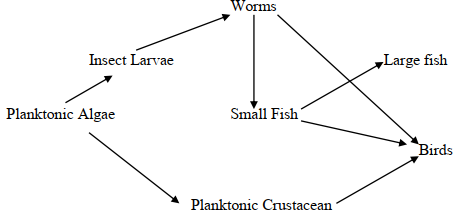
-
- Planktonic algae → Planktonic crustacean → Birds
- Planktonic algae → Planktonic crustacean → Small fish → Large fish
- Producers must always have a higher biomass than consumers because they support the consumers which are at higher trophic levels
- Pollution – herbicides and pesticides, over fishing, bird hunting
- Herbicides and pesticides – kill insect and planktonic algae reducing their number.
- Fishing increases planktonic crustaceans and insect larvae leading to over consumption of algae depleting them.
- Decrease in number of insect larva.
-
-
- A - Desert, arid and semi-arid
- B - Aquatic, marshy land
- A - Desert, arid and semi-arid
-
-
- 1968
- Hot water, sewage and industrial waste.
- High temperature reduces dissolved oxygen causing suffocation of fish.
- Sewage leads to eutrophication reducing oxygen concentration and reduces penetration of light.
- Industrial waste- toxic substance kills the organism.
-
- A = 7512-20 = 7492/5
= 1498.4 fish per year
B = 617- 23 = 594/5
= 118.8 fish per year
Difference = 1379.6 fish per year - - Reproductive rate
- Competition
- Predation
- Sex ratio
- A = 7512-20 = 7492/5
-
- Capture/recapture method
- Marks may disappear
During marking fish may be killed
Predation/death may interfere.
-
- The pollutants may be absorbed by aquatic plants which in turn may be eaten by fishes. The pollutants therefore get into man through the food chain.
- - Improving sanitation to prevent infection by parasite.
- Insecticide to kill vector like mosquitoes or tsetse fly.
- Avoid indiscriminate sexual intercourse to prevent spread of parasites. -
- Green plants → Grasshoppers → Lizards → Snakes
Green plants → Grasshoppers → Lizards → Cats
Green plants → Mice → Snakes → Hawk
Green plants → Mice → Snakes → Cats - Mice
- Lizard, cats, hawk, snakes.
- Most plants will die
Some organisms will starve and die
Some organisms may migrate.
- Green plants → Grasshoppers → Lizards → Snakes
-
- Population size
N = 374 x 400 = 1870
80 - There was even distribution of crabs; No movement in and out of lagoon/on migration. There was random distribution of crabs after first capture
- Capture, mark, release then recapture/capture/recapture method.
- Population size
-
- Grass → Grasshopper → Guinea fowls
Grass → Termite → Guinea fowls - Lions would complete with leopards
Gazelle number would reduce
Grass would be increased - Grass
- Grass → Grasshopper → Guinea fowls
-
- E -Denitrifying bacteria
J - Nitrifying bacteria - F- Nitrogen fixation
H-Decomposition - G-Plants
- E -Denitrifying bacteria
-
- Community – it is the total number of plants and animals living together in an area.
Population - total number of organisms of a given species occupying an area at a certain trophic level - - Use of net to capture the grasshopper
- Which are then counted and marked. They are then released.
- Total number of grasshoppers is determined by multiplying the grasshoppers captured second time by those captured and marked first time.
- The sum is divided by number of grasshoppers marked in second capture.
- Community – it is the total number of plants and animals living together in an area.
- - During manufacture of sulphuric acid and nitric acids oxide of sulphur and nitrogen are released into air causing acid rain.
- Motor vehicle exhaust fumes release carbon monoxide a respiratory poison.
- Combustion of fuels and coal increase concentration of carbon dioxide creating greenhouse effect.
- Aerosols containing CFC in herbicides and perfumes deplete the ozone layer.
- Smoke from factories mix with fog forming smog which reduces visibility.
- Exhaust fumes from vehicles contains lead from leaded petrol that poisons the body.
- Deforestation exposes top soil to air currents encouraging sheet erosion
- Leaded petrol that poisons the body.
- Loud noise from factories, aeroplanes and Jua Kali workshops can lead to poor hearing ability.
- Radio active emissions can lead to mutations. - Curved sharp hooked strong beaks for killing or tearing flesh from bones.
Curved strong sharp claws for holding prey. -
- Crop- potato/tomato
Disease- potato blight/tomatoes rot - - Use of fungicides
- Uprooting and burning infected plants
- Crop rotation
- Use biological control
- Use disease resistant varieties
- Crop- potato/tomato
- Cattle are mainly grazers while most wild animals are browsers.
-
- Study of a single species within a community or ecosystem.
- Study of different species of organisms in a natural community in an ecosystem.
- A-Aquatic/Fresh water
B- Forest
C- Arid- Semi Arid - - Sunken stomata,
- Reversed rhythm
- Small stomatal pores
- Entamoeba histolytica
-
- Photosynthesis
- Heterotrophic
- Aquatic (pond) and terrestrial (forest)
- Algae → Zooplankton → Small fish → Bird J → Large bird
- - Number of snails would increase
- Green plants would decrease.
- Bird M would increase - In a lower trophic level energy is lost through respiration, excretion and death of some organisms.
- - Vultures
- Decomposers - Vultures- control population of the large birds.
Decomposers- cause decay of dead organisms recycling the nutrients.
- - Vultures
- - Deforestation
- Bird hunting
- Over fishing - Removal of the trees destroys the habitat for birds, they therefore migrate.
- Bird hunting kills the birds reducing their number and increasing small fish, mussels and snails.
- Over fishing reduces the number of small fish increasing zooplankton and reducing the algae
- - Deforestation
- - Cells have large air spaces between them to enhance buoyancy.
- Cells are air filled reducing their density. - Light- high light intensity increase the rate of photosynthesis
Temperature- low temperatures lower metabolic activities while moderate temperature increase metabolic activities. High temperature increases transpiration.
Wind - Strong air current increase rate of transpiration and deforms the plants according to direction of the wind.
Atmosphere pressure - High pressures decrease the rate of transpiration and also reduces rate of photosynthesis.
Ph value - some plants thrive well in acid soils while others thrive better in alkaline soils.
Radioactive radiations - Cause mutations of the offspring
Oxides of sulphur and nitrogen - cause acid rain that corrodes plant leaves. -
- Decomposers – Cause breakdown of organic matter enhancing recycling of nutrients
- Predation - The organism feeds on whole or part of another organism and therefore control their population.
- X- Denitrification
Y- Animals
Z- Nitrification -
- Pyramid of number Way numbers of individuals occurring at each trophic levels of a food chain may be diagrammatically represented.
Pyramid of biomass The way the total amount of living matter occurring at each trophic level of food chain may be diagrammatically represented. - - Loss through excretion e.g. egestion
- Heat
- Respiration - - Two parallel strings are laid down over a determined length and width within study area.
- No. of organisms in belt transect are counted.
- Area transect is worked out.
- Number of organisms per unit area is worked out.
- Pyramid of number Way numbers of individuals occurring at each trophic levels of a food chain may be diagrammatically represented.
-
- Population – It is all members of a given species in a particular habitat at a particular time.
Community – All organisms belonging to different species that interact in the same habitat. - Capture and recapture method.
- Line transect
- Population – It is all members of a given species in a particular habitat at a particular time.
- - Produce large number of eggs for increased survival.
- Produce enzymes to digest human skin when penetrating.
- Can withstand low oxygen concentration.
- Have hook-like structures to attach to the intestinal walls. - - It is addition of substances into water that may cause harm to organisms and are destructive to the ecosystem.
The causes of water pollution include;- Industrial effluents that may be toxic chemicals which may kill the aquatic organisms. It can be controlled by treating the affluent before discharging them.
- Hot water that reduces concentration of oxygen, killing the animals. It is controlled by placing high penalties on factories discharging hot water.
- Oil spillage from oil tankers that reduces oxygen in water, penetration of light intensity and clog feathers of marine birds. It can be controlled by regular servicing of oil tankers.
- Domestic effluents that include;
- Untreated sewage that causes water borne diseases. It can be controlled by treating sewage before being discharged.
- Detergents that cause eutrophication causing reduced oxygen concentration. It is controlled by banning phosphate based detergents. - Agricultural effluents that include;
- Pesticides and herbicides that have heavy metals that they may gammulates along the food chain killing the higher animals. It is controlled by banning phosphate based detergents.
- Inorganic fertilizers that have nitrates and sulphates that cause eutrophication. It is controlled by use of organic fertilizers. - Silting due to soil erosion that reduces penetration of light to the plants and clog respiratory surfaces of animals. It is controlled by proper methods of soil erosion control and proper farming methods.
-
- It is use of natural predator to kill a prey e.g pest instead of use of pesticide.
- The aphids are pest found in plants. The ladybirds can be used to control the aphids as they feed on them but not destroy the plants
- Prey is the source of food for predators. If the number of prey is smaller than the predators they would be depleted.
-
- Antelopes are grazers while giraffes are browsers.
Antelopes have brown fur being camouflaged by the colour of grass while giraffes are camouflaged by the trees. - Trees are camouflage against the herbivores preventing them from being spotted by predators. In open grassland herbivores are easily spotted.
- The population will first increase leading to competition of resource e.g. food or mates. This causes death of the weak herbivores or migrations to new habitats.
- Antelopes are grazers while giraffes are browsers.
- - As it gets deeper light penetration decreases reducing rate of photosynthesis hence less productivity.
- As it gets deeper carbon dioxide concentration decrease hence reducing rate of photosynthesis hence less productivity -
- Plant protein
- X-Nitrification
Y-Nitrogen fixation
Z- Dentrification - Proteins
-
-
- 25-10 = 15 birds
- 20-5 = 15 birds
-
- The number of species in forest are more than in the number in the savannah hence higher change.
Fruits more abundant in forest than in savannah
Selectively reduces with forest birds because they are many and competition is stiffer than savannah - Seeds more abundant in savannah than in forest-they they are more exposed but seeds in forest plants are inside the fruit.
Birds in savannah are less selective than forest birds.
- The number of species in forest are more than in the number in the savannah hence higher change.
-
- B
- - Emigration in big numbers
- High death rate during unsuitable condition and disease.
- Predation increase due to attraction of predator due to their high number.
- - Bush fire –avoid lighting fires
- Eliminating all predators of one herbivore
- Limited predator to maintain high biological control.
- Felling trees- replanting trees
- Having high concentration of industries that provides that cause acid rain.
- Use of fuels that do not produce the oxides
-
Join our whatsapp group for latest updates
Tap Here to Download for 50/-
Get on WhatsApp for 50/-
Download Ecology Questions and Answers - Biology Form 3 Topical Revision.
Tap Here to Download for 50/-
Get on WhatsApp for 50/-
Why download?
- ✔ To read offline at any time.
- ✔ To Print at your convenience
- ✔ Share Easily with Friends / Students

